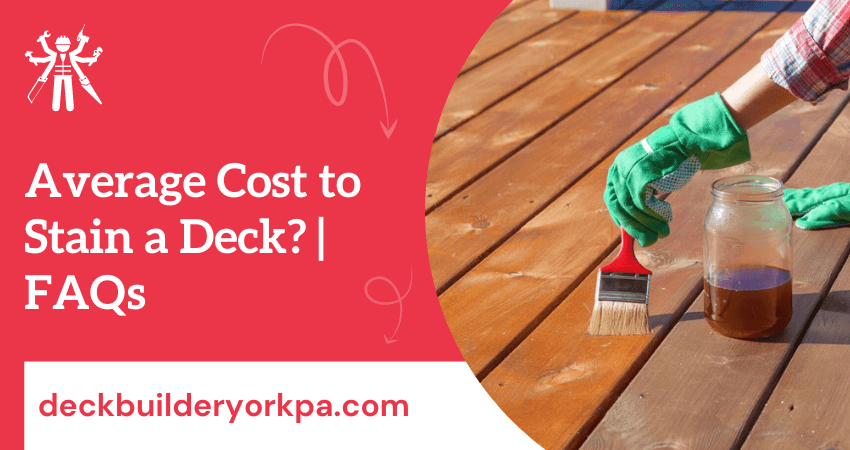Average Cost to Stain a Deck? | FAQs
Staining a deck is an important part of the maintenance routine to help preserve its beauty and extend its life. But how much does it cost and what do you need to consider to get the best results?
In this blog post, we’ll explore what factors influence the overall price of staining your deck, as well as tips for getting great-looking results without breaking the bank. Whether you’re planning on tackling this project yourself or leaving it up to deck building company, reading ahead will help make sure that your money is wisely invested and ensure a lasting finish.
Average Cost To Stain Deck
The average cost to stain a deck will depend on the size and condition of the deck, as well as the complexity of the job. On average, it is usually around $2.00-$4.50 per square foot for both labor and materials.
This would include power washing, cleaning, sanding, staining and sealing with a clear finish. Keep in mind that if the deck is in bad condition or large, the cost will be higher. Also, if you choose to use a more expensive stain and sealer it can increase the cost significantly.
In addition, hiring a professional with experience can often result in a better job and higher costs. If there are any damaged areas of the deck, you may also need to factor in additional costs for repairs.
All in all, it is important to get quotes from multiple contractors and compare their estimates before making a final decision. This will ensure that you are getting the best value for your money.
What factors affect the overall cost of staining a deck?
The cost of staining a deck depends on several factors, including the size of the deck, the type and quality of the stain used, the complexity of the job (multiple stories or difficult-to-reach areas) and labor fees.
The costs for supplies such as brushes, rollers and drop cloths should also be factored in when calculating the overall cost of staining a deck. Most stains will require more than one coat to achieve the desired outcome, so this should be taken into account as well. In addition, if the deck needs any repairs before staining such as sanding or replacing rotten boards, this could increase the cost of staining the deck.
Finally, the local cost of living can also affect the overall cost of staining a deck. If labor costs are higher in your area, this could add to the total cost. By taking into consideration all these factors, you can get an accurate estimate of the price for staining your deck. Talking to local contractors or deck-staining professionals is also a great way to get an accurate estimate of the cost.
No matter what, it’s important to do some research and compare prices before hiring someone to stain your deck. Doing so will help you find the best value for your money and ensure that you get quality work done on time.
It’s also important to remember that the cost of staining a deck may be more than just money. If done incorrectly, staining can damage your deck and require costly repairs in the future. So make sure to take all factors into account before making any decisions.
Which parts of the deck are most expensive to stain?
The cost of staining a deck can vary widely depending on the type and quality of the stain used, as well as the size, condition and complexity of the job. The most expensive areas to stain are typically high-traffic areas such as stairs, railings and around windows or doors.
This is because these surfaces will require more attention and stain, whereas other areas of the deck may only need a single coat. Other cost factors include whether you choose to hire a professional or do it yourself, as well as the type of stain you use.
Solid-color stains are typically more expensive due to their thicker consistency and enhanced protection against fading or water damage. Semi-transparent or transparent stains are generally cheaper than solid-color stains because they offer less protection. Ultimately, the cost of staining a deck will depend on the size, complexity and condition of the job, as well as the type and quality of stain chosen.
For most decks, the cost of staining should be considered an investment in protecting and enhancing your outdoor space. A good-quality stain will last much longer than a low-quality alternative, saving you money in the long run.
Taking proper care to prep the deck before staining and selecting a high-quality product will help ensure that your deck looks great and lasts for years to come.
How long will the stain last before it needs to be reapplied?
The longevity of a stain depends on several factors, such as the type and quality of the staining product used, how well it was applied, the weather conditions in your area and any other external elements that may affect its lifespan.
In general, most stains will last between one and three years before they need to be reapplied. For best results, you may want to re-stain your deck or fence every two years. This will ensure that the stain continues to protect and beautify your outdoor living spaces. Additionally, if you live in an area with harsh weather conditions, such as extreme heat or cold, it’s best to inspect your stain annually and reapply as needed.
Remember, regular maintenance and care can help preserve the beauty of your outdoor living spaces for years to come. So if you want your deck or fence to be looking its best, make sure you’re up-keeping it with regular staining!
What kind of preparation is needed before staining a deck?
Before staining a deck, it is important to properly prepare the surface for optimal results. This includes cleaning the deck with a pressure washer or scrub brush, sanding down any rough patches and peeling paint, removing dust and debris from the surface with a broom and pre-treating spots of mildew or mold.
It is also important to make sure that the deck is completely dry before staining, as moisture can hinder the absorption of the stain. Applying a primer or sealer prior to staining can help protect the wood from damage and keep it looking fresh for longer.
Lastly, make sure to test a small area of your deck with a sample of your chosen stain before committing to the entire project.
Which products work best for staining a deck?
- Oil-based stains: Oil-based stains are the most popular choice for staining a deck and offer rich, vibrant colors that can last for several years. They provide excellent protection against moisture and UV damage but must be recoated every two to three years.
- Semi-transparent stain: This type of stain provides a natural look to your deck, letting the wood grain show through but still providing some protection from moisture and UV damage. Semi-transparent stains usually last for up to two years before needing to be recoated.
- Solid stain: This type of stain offers a uniform, opaque color that can last several years. It is more resistant to UV damage and moisture than other types of stain, but it can be harder to apply and may require the use of a sprayer.
- Clear sealer: Clear sealers offer minimal color change but provide protection against moisture, UV rays and wear and tear. This type of stain is best for decks that have already been stained or sealed and need an extra layer of protection. Clear sealers must be recoated every one to two years.
- Water-based stains: Water-based stains are easier to apply than oil-based stains and offer good UV protection, but they do not last as long and must be recoated more often. No matter which type of stain you choose, it’s important to properly prepare the surface of your deck before applying any product.
Final Thoughts
As you can see, the average cost to stain a deck can vary depending on several factors. The biggest factor is the square footage of your deck. If you have a large deck, you can expect to pay more for the materials and labor.
Another important factor is the type of stain you choose. Some stains are more expensive than others. You also need to consider whether you hire a professional or do it yourself.
Generally, hiring a professional will cost more, but it may be worth it for the convenience and peace of mind. When deciding whether to stain your deck or hire a professional, be sure to weigh all the factors involved so you can make the best decision for your situation.







